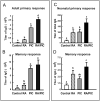Vitamin A supplementation and retinoic acid treatment in the regulation of antibody responses in vivo
- PMID: 17368317
- PMCID: PMC3843126
- DOI: 10.1016/S0083-6729(06)75008-7
Vitamin A supplementation and retinoic acid treatment in the regulation of antibody responses in vivo
Abstract
Vitamin A (VA, retinol) is essential for normal immune system maturation, but the effect of VA(1) on antibody production, the hallmark of successful vaccination, is still not well understood. In countries where VA deficiency is a public health problem, many children worldwide are now receiving VA along with immunizations against poliovirus, measles, diphtheria, pertussis, and tetanus. The primary goal has been to provide enough VA to protect against the development of VA deficiency for a period of 4-6 months. However, it is also possible that VA might promote the vaccine antibody response. Several community studies, generally of small size, have been conducted in children supplemented with VA at the time of immunization, as promoted by the World Health Organization/UNICEF. However, only a few studies have reported differences in antibody titers or seroconversion rates due to VA. However, VA status was not directly assessed, and in some communities children were often breast fed, another strategy for preventing VA deficiency. Some of the vaccines used induced a high rate of seroconversion, even without VA. In children likely to have been VA deficient, oral polio vaccine seroconversion rate was increased by VA. In animal models, where VA status was controlled and VA deficiency confirmed, the antibody response to T-cell-dependent (TD) and polysaccharide antigens was significantly reduced, congruent with other defects in innate and adaptive immunity. Moreover, the active metabolite of VA, retinoic acid (RA) can potentiate antibody production to TD antigens in normal adult and neonatal animals. We speculate that numerous animal studies have correctly identified VA deficiency as a risk factor for low antibody production. A lack of effect of VA in human studies could be due to a low rate of VA deficiency in the populations studied or low sample numbers. The ability to detect differences in antibody response may also depend on the vaccine-adjuvant combination used. Future studies of VA supplementation and immunization should include assessment of VA status and a sufficiently large sample size. It would also be worthwhile to test the effect of neonatal VA supplementation on the response to immunization given after 6 months to 1 year of age, as VA supplementation, by preventing the onset of VA deficiency, may improve the response to immunizations given later on.
Figures


Similar articles
-
Neonatal-age treatment with vitamin A delays postweaning vitamin A deficiency and increases the antibody response to T-cell dependent antigens in young adult rats fed a vitamin A-deficient diet.J Nutr. 2007 May;137(5):1229-35. doi: 10.1093/jn/137.5.1229. J Nutr. 2007. PMID: 17449586 Free PMC article.
-
Randomised trial of effect of vitamin A supplementation on antibody response to measles vaccine in Guinea-Bissau, west Africa.Lancet. 1997 Jul 12;350(9071):101-5. doi: 10.1016/S0140-6736(96)12019-5. Lancet. 1997. PMID: 9228962 Clinical Trial.
-
Vitamin A supplementation of women postpartum and of their infants at immunization alters breast milk retinol and infant vitamin A status.J Nutr. 2002 Nov;132(11):3243-8. doi: 10.1093/jn/132.11.3243. J Nutr. 2002. PMID: 12421835 Clinical Trial.
-
Effects of vitamins, including vitamin A, on HIV/AIDS patients.Vitam Horm. 2007;75:355-83. doi: 10.1016/S0083-6729(06)75013-0. Vitam Horm. 2007. PMID: 17368322 Review.
-
Heterologous and sex differential effects of administering vitamin A supplementation with vaccines.Trans R Soc Trop Med Hyg. 2015 Jan;109(1):36-45. doi: 10.1093/trstmh/tru184. Epub 2014 Dec 3. Trans R Soc Trop Med Hyg. 2015. PMID: 25477326 Free PMC article. Review.
Cited by
-
Metabolism of Neonatal Vitamin A Supplementation: A Systematic Review.Adv Nutr. 2021 Jun 1;12(3):942-958. doi: 10.1093/advances/nmaa137. Adv Nutr. 2021. PMID: 33216111 Free PMC article.
-
Potential for use of retinoic acid as an oral vaccine adjuvant.Philos Trans R Soc Lond B Biol Sci. 2015 Jun 19;370(1671):20140145. doi: 10.1098/rstb.2014.0145. Philos Trans R Soc Lond B Biol Sci. 2015. PMID: 25964457 Free PMC article. Review.
-
Toll-like receptor 3 ligand and retinoic acid enhance germinal center formation and increase the tetanus toxoid vaccine response.Clin Vaccine Immunol. 2009 Oct;16(10):1476-84. doi: 10.1128/CVI.00282-09. Epub 2009 Aug 19. Clin Vaccine Immunol. 2009. PMID: 19692622 Free PMC article.
-
Questioning Cause and Effect: Children with Severe Asthma Exhibit High Levels of Inflammatory Biomarkers Including Beta-Hexosaminidase, but Low Levels of Vitamin A and Immunoglobulins.Biomedicines. 2020 Oct 6;8(10):393. doi: 10.3390/biomedicines8100393. Biomedicines. 2020. PMID: 33036262 Free PMC article.
-
Retinoic acid-induced IgG production in TLR-activated human primary B cells involves ULK1-mediated autophagy.Autophagy. 2015;11(3):460-71. doi: 10.1080/15548627.2015.1009797. Autophagy. 2015. PMID: 25749095 Free PMC article.
References
-
- Altucci L, Gronemeyer H. The promise of retinoids to fight against cancer. Nat Rev. 2001;1:181–193. - PubMed
-
- Arora D, Ross AC. Antibody response against tetanus toxoid is enhanced by lipopolysaccharide or tumor necrosis factor-alpha in vitamin A-sufficient and -deficient rats. Am J Clin Nutr. 1994;59:922–928. - PubMed
-
- Bahl R, Bhandari N, Wahed MA, Kumar GT, Bhan MK, Vitami WCIL. Vitamin A supplementation of women postpartum and of their infants at immunization alters breast milk retinol and infant vitamin A status. J Nutr. 2002;132:3243–3248. - PubMed
-
- Baxevanis CN, Gritzapis AD, Papamichail M. In vivo antitumor activity of NKT cells activated by the combination of IL-12 and IL-18. J Immunol. 2003;171:2953–2959. - PubMed
Publication types
MeSH terms
Substances
Grants and funding
LinkOut - more resources
Full Text Sources
Medical

